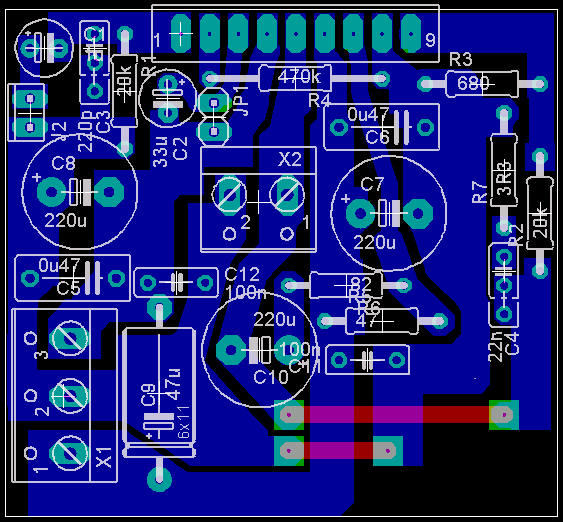| Start | Gleitschirm | Motorrad | Elektronik | Reisen | Seti@Home | Computer | Ratten | Ueber mich | Sitemap | Impressum |
|
Simple but good 45W Audio Amplifier with TDA 1514A
The TDA 1514A made by Philips Semiconductors is an integrated 50 Watt hifi audio amplifier. The main difference compared to other amplifier chips in this power class is, that it has very low distortion and noise (THD+N) and a pretty high slew rate. On the other hand, it does not work with a single 12 Volt or 15 Volt power supply, because it is not mainly planed for automotive designs.
I am calling the amp a 45 Watt amp, because I am running it at +-22V power supply into a 4 Ohm speaker. In this configuration the resulting power is appx. 45 Watts. Please see the data sheet for more information.
On this page, it is shown, how to build a mono amplifier, using this chip. Of course you can easily make it a stereo amp, using two identical PCBs. I have even build 2 channels on one bigger piece of PCB material. The complete set of data is available for download, including the schematic, the board layout and description. I have built this amplifier several times and it works very good. I use it for example in my 6 channel amplifier, that is connected to my computer. Two of the channels are made up of two of this amps and the remaining four channels are made up with a different, less powerful chip, which can also be found elsewhere on this page.
What this circuit provides and what it does not provide:
All protection features of the chip are supported, The "Mute/Standby" input is not used, but available on a two pin header. There is no volume or sound control. The circuit is not a preamp, but a naked power amp.
The schematic is basically taken from Philips Semiconductors data sheet for the TDA 1514A, which can be downloaded here: tda_1514.pdf (75kB) .

The board layout is very small. Remember, that I designed it for use in a 6 channel amp. I wanted it to be small and handy. The single sided pcb is only appx. 48x 44 mm (1.9x1.65 inches) big. There are two wire bridges shown in red color. Use a bit thicker wire for them. J2 (upper pin) is the input, X2 (right pin) the speaker output. The X1 pins are V+, Gnd and V- (bottom to top). JP1 can be used for "Mute". You do not need to connect them to anywhere. It's just in case you want to use that feature sometimes. I have tinned the Output, Power supply and ground traces on the PCB, because they carry higher currents. This layout has two major advantages. It has proven to work and has a very small footprint. But there is no light without shadow.
Here are some of the disadvantages:
Input and Mute headers are in 2.54 mm (1/10 inch) grid. That is small. I soldered a 2-pin header into the board for the Input and then soldered the wires to the pins. For the outputs I drilled bigger holes (1.2 mm or appx 1/20 inch) and soldered the wires to the pcb directly. For the power supply I used a regular three pin header. The header just fits on the pcb.
Still want to build this shit ? ;-))

Building the baby is as simple as it looks from the above layout picture.
Download the data package. It contains the PCB layout in different file formats.
To keep the layout simple and nice, I did not try to avoid wire bridges. So there are actually 2 of them on the board. Assemble and solder the parts in the order of their height. Start with the most flat part (wire bridges).
A few words about the power supply. The TDA1514A accepts a wide range of suplly voltages. Our circuit is designed for a split power supply. A good choice is anything from +-23V for 4 Ohm Speakers, up to +-30V for 8 Ohm systems. Higher voltages than +-23V with 4 Ohms load do not bring you any advantages, but more heat. Lower voltages will decrease the maximum output power. My transformer gives me 2 x 18 Volts. After conversion to DC, the voltage without any load is +-25V. Under heavy load, I still have appx. +-22 V. As I am only using 4 Ohm speakers, this will allways give me almost maximum power, while the level of heat dissipation is still reasonable. You can find a power supply schematic and layout somewhere else on this page as well.
Testing can be done very easily, with only a multimeter. First of all, connect the inputs to ground. Connect the power supply, but make sure to use 3 Ampere fuses in the power supply unit for testing. If the 3A fuses blow, something is totally wrong. Switch the multimeter to 20V AC voltage and measure the amp output. Decrease the voltage display range step by step. You should not find a voltage there. If you don't find an AC voltage, then there is no hum or noise on the output with grounded inputs. That's good. Next switch the multimeter to 20V DC voltage and measure the output again. Decrease voltage range step by step. There should not be a significant DC voltage on the output, as this could toast your speaker. I would say up to 50 Millivolts are OK. Now you could connect a speaker. You should not hear hum or hiss. Next, connect an input source, such as your PCs line out. Make sure to set the output volume in the PC to minimum first. Then slowly increase it and ENJOY ! :-)